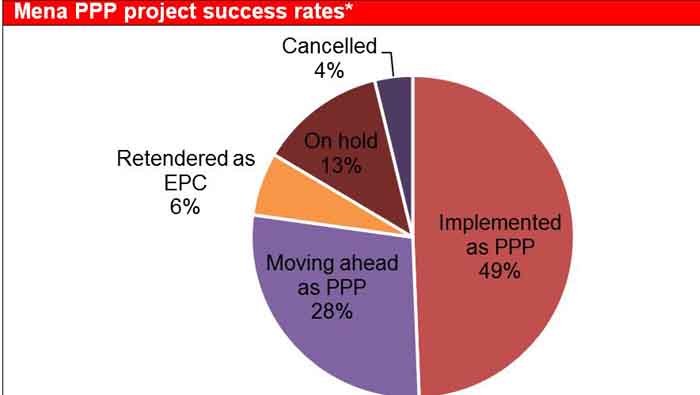
Muscat: Nearly one in four public private partnership (PPP) projects launched in the Middle East and North Africa (Mena) have been abandoned, according to research by Middle East business intelligence service MEED.
MEED’s latest report on the region’s PPP market shows that 23 per cent of the 80 PPP projects brought to market in the Mena region since 1996 failed to conclude in a deal.
The primary reason identified for PPP deals not getting off the ground was seen to be governments failing to offer deal structures that were attractive to investors because they carried too much investment risk, either from a lack of detail in the project scope, or inadequate guarantees over revenues.
The findings come as governments across the region are turning to PPP contracts to deliver key projects in order to reduce spending in response to lower oil earnings.
Deal analysis
In preparing its latest research report, PPP in the Middle East, MEED analysed more than 100 projects across the Mena region including 80 PPP projects that have reached the prequalification stage in the region since 1996.
The results showed that about 49 per cent of all PPP projects brought to the market in the Mena region since 1996 had reached financial close while 23 per cent failed to reach financial close.
The remainder of the deals, about 28 per cent, remain at different stages of development ranging from seeking expressions of interest (EoI) from prospective developers, to having signed the PPP contract but still working towards a financial close.
MEED’s analysis of the PPP market highlights the importance of carefully selecting projects, and carrying out proper feasibility and financial studies before projects are brought to market.
MEED says that the most common reason given for the failure of PPP deal to be concluded in the region was poor deal structuring, where investors feel that they have been asked to accept structures that require them to accept high levels of risk while expected revenues are unclear.
Risk allocation
As a result of poorly defined deal structures, investors are forced to increase their contract bid prices in order to mitigate exposure to potential and unforeseen risk. As a consequence, the overall cost of the project rises, making it economically unviable.
In one example highlighted by MEED, Egypt’s October 6 Wastewater Treatment Plant PPP, launched by Cairo in 2009, was abandoned in 2012 after studies showed higher-than-expected levels of industrial wastewater required to be treated. This required more advanced pre-treatment technology than had been anticipated, making the project prohibitively expensive.
Although PPP has become an established method for delivering government projects around the world, it has had a relatively low level of uptake in the Middle East region.
PPP contracts offer companies long-term concessions to run government services such as operating a hospital, a school or a water treatment plant, in return for making the necessary up-front capital investment.
Efficiency
Advocates say the PPP model allows governments to introduce private sector efficiencies andallows them to reduce spending, while giving private companies the security of predictable long-term revenues. Critics meanwhile say that PPP projects cost the government more over their lifetime than they would under traditional procurement models.
Additionally, PPP deals are notoriously complex and expensive to agree as the investors seek as much certainty as possible on what they are required to provide and what revenues they will earn, while the government wants to ensure that it is getting the best possible service over the lifetime of the deal.
Land transport has the highest failure rate across the sectors, as projects such as the Saudi Landbridge and the Mafraq-Gweifat International Highway in Abu Dhabi proved too expensive to undertake using PPP.
Successful logistics projects bring the land transport success rate to 14 per cent so far, with 43 per cent still in the pipeline.
Build-operate-transfer (BOT) port projects have also seen a high failure rate, including Aqaba New Port in Jordan and the Tanger port complex in Morocco. Port concessions without construction work, especially at Tanger-Med Port, have been much more successful.
The water sector, including wastewater treatment and utility concessions, has the highest success rate at 74 per cent, with 11 per cent still in the pipeline.